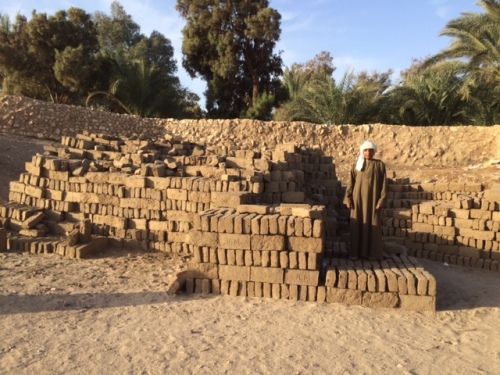Tony Crosby
We cannot begin to know how many mud bricks were actually used to construct Amenhotep III’s palace at Malqata, but we can develop a rough estimate. To start with, the enclosure wall is 2.5 meters thick and was probably over 600 meters long. Each 1 meter of length of a wall 1 meter high requires 540 bricks – if the wall was only 2 meters high, over half a million bricks would be necessary. But a 2.5 meter thick wall would surely be at least 3 meters high, so I’m raising our estimate of the number of bricks in the enclosure walls to slightly more than 800,000.
The walls comprising the palace rooms generally are much thinner, the majority being 0.6 meters thick, although some are only 20 cm thick and some are 1.6 meters thick. For the sake of argument, let’s say that the average thickness of the palace walls is 0.6 meters. Our estimate of the length of all walls in the palace is 1800 meters, or more than one mile. After some additional quick math we estimate that if all the walls were 2 meters high, the total number of mud bricks would be about 400,000.
Oh, we forgot the floor paving… For our estimates let’s say there was 7,500 square meters of paving. If we assume that the paving bricks were considerably larger than the wall bricks, as they are in the west villas, our estimate is an additional 60,000 “really big bricks.”

Stacks of new mud bricks. This is a stack of about 3,000 bricks. Can you imagine what a stack of approximately 400 times more bricks would look like?
So without really trying, we are up to 1,460,000 mud bricks, or to round it off, say 1.5 million. Now we haven’t counted the North Palace, West Villas (the administrative area), the Amun temple, the Audience Pavilion, or other mud brick features of the immediate site. Rather than trying to calculate these, for now let’s just double the 1.5 million: that’s 3,000,000 mud bricks of various sizes. A good brick maker can make about 1,000 bricks a day of the smaller sizes, but might produce only 600 a day of the larger sizes. For the sake of estimating even further, let’s say his average production is 800 per day. Rounding off again, it would take approximately 2000 days for one man to make the estimated number of bricks for the palace, or 1 day for 2000 men. . . or something in between! Of course you have to figure in sick leave, holidays and vacation, but I’ll leave that to you.

Mud-brick perimeter wall in the Palace, under construction. The current view is probably not too different from the view 3400 years ago!
Okay, so we have a lot of bricks, no doubt a lot of builders, different sized bricks, quite a few different mud brick bonding patterns, and probably a pretty tight work schedule. You also have a site that slopes from south to north and west to east, some “change orders” thrown in, and craftsmen and artisans who want things done their way. All these are just normal construction factors that the king had to consider and resolve when needed, on top of planning the festival itself! And then there is the plastering prior to painting. It’s just too much. I’m going back to counting bricks…

Reblogged this on An Archaeologist's Diary and commented:
Bricks, bricks, nothing but bricks… and math! A fun post from Malqata… about bricks. Lots of bricks.
By: Caroline on February 24, 2015
at 2:57 pm